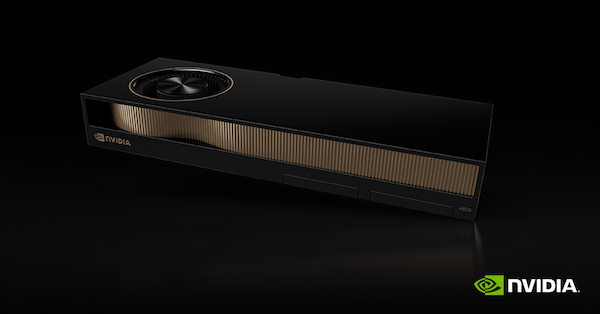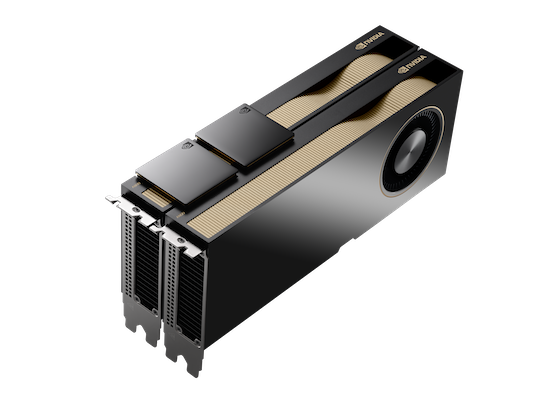HPC Performance on the Desktop: NVIDIA A800 40GB Active GPU
The new NVIDIA GPU provides powerful, double-precision capabilities for demanding engineering simulation workflows.

Image courtesy of NVIDIA
Latest News
January 15, 2024
NVIDIA has launched the A800 40GB Active GPU for desktop workstations, providing FP64/double precision compute capabilities for computer aided engineering (CAE) applications. The new GPU is a replacement for the NVIDIA® Quadro® GV100. It's powered by the Ampere architecture and delivers incredible performance for the most demanding workflows on workstation platforms—from AI training and inference, to complex engineering simulations, and data analysis.To offer out-of-the-box performance for AI, each NVIDIA A800 40GB Active GPU comes with a subscription to NVIDIA AI Enterprise, an end-to-end enterprise software platform for rapid development and deployment of production-ready generative AI, computer vision, speech AI, and more.
The A800 40GB Active is a headless board without video inputs, so would need to be paired with a compatible companion NVIDIA GPU, such as the NVIDIA RTX 4000 Ada Generation, RTX 4000, or T1000 GPU, for applications that require graphics.
FP64/double precision compute is used in applications that require high levels of numerical precision, such as simulation workflows that involve solving large sets of partial differential equations. FP64 allows for representation of very large and very small numbers with a high degree of accuracy.
The new A800 40GB Active supports NVIDIA NVLink® technology, providing the ability to connect two A800 40GB Active GPUs together to share GPU memory with 400GB per second of bidirectional bandwidth, , 40GB of high-speed HBM2 memory, and 1.5 TB/s of memory bandwidth, as well as 9.7 TFLOPS of double-precision performance (19.5 TFLOPS for single-precision).
The A800 40GB Active is available in professional engineering workstations, including the Dell Precision 7960, Dell Precision 5860, Dell Precision 7875, and the Dell Precision 7960 Rack.

Image courtesy of NVIDIA.
We spoke to Allen Bourgoyne, director of product marketing for professional solutions at NVIDIA, about the advantages of the new GPU.
First, just to clarify, the new A800 40GB Active is a different product than the A800 data center GPU that was available internationally, correct?
Yes, the original A800 was a data center product that was passively cooled and was created for international markets. This product is actively cooled with a fan and is designed for workstations.
This is a two-slot PCIe board that can fit in a workstation and provides 64-bit compute capabilities.
How does it compare to its predecessor, the GV100?
It is a lot faster – it provides roughly double the performance with more memory bandwidth. It gives you a nicer overall experience.
Another difference is that there are no display outputs on this board, so you will need another NVIDIA GPU if you want to display on the same machine. We qualify our NVIDIA T1000 and RTX 4000 Ada series GPUs. Given the density of the latest generation of workstations, you could put three A800s in a workstation along with the visualization GPU in one of the high-end products.
In the engineering space, who are the target end users for this type of processor?
The target workstation use cases would be people who need high-performance compute, users running simulations – particularly if they require 64-bit computing. The A800 is very fast regardless of the type of computation, but it does support 64-bit at full speed. You get a very fast double-precision compute. Traditionally, these users may have run those calculations on a server, but now they can do it locally on a desktop.
In simulation applications like fluid dynamics, electromagnetics, particle simulations, etc., a lot of times these users need double-precision compute to get the accuracy they need. There are also HPC codes in biomedical applications that look at things like reactions or chemical interactions that use double precision. When people study things that are very small or very large, they need that level of precision.
Are you seeing demand for this type of compute power increase in the engineering space?
What we have seen over several years, even going back to the NVIDIA GV100, there has been growth among smaller companies and firms that do not have data centers and don't want to rent time in a data center. If they can do that compute locally, it's more efficient for them. There has been a proliferation of tools that encourage simulating earlier, and simulating more often, and having this capability on the desktop can enable that.
With artificial intelligence (AI) becoming more prevalent, products like the A800 includes the NVIDIA AI Enterprise software solution and can also provide the compute power users need to handle those applications as well. We will see AI helping with more simulations, especially to simulate things that are very large. If you can use AI to compress and shorten those simulation times, that is great for everybody, and you will see more use for cards like the NVIDIA A800 40GB Active.
More Dell Coverage

More NVIDIA Coverage
Subscribe to our FREE magazine, FREE email newsletters or both!
Latest News








